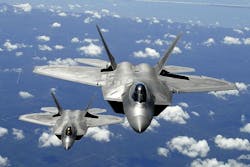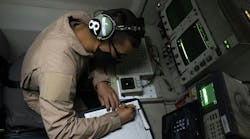Officials of the U.S. Air Force Research Laboratory at Wright-Patterson Air Force Base, Ohio, awarded a $36.4 million contract late last month to the Lockheed Martin Aeronautics segment in Fort Worth, Texas, for phase 2 of the System of Systems Integration Technology and Experimentation (SoSITE) program.
The Air Force Research Lab awarded the contract on behalf of the U.S. Defense Advanced Research Projects Agency (DARPA) in Arlington, Va., which is sponsoring the SoSITE program.
This initiative seeks to help U.S. combat aircraft designers overcome the problems of long aircraft design cycles and easy access of enemies to advanced technologies that mitigate the global air superiority that U.S. forces have maintained since the end of World War II.
The SoSITE program seeks to show that a system-of-systems (SoS) approach can help maintain U.S. air superiority in contested airspace with high risk of enemy electronic jamming, enemy fighters, and surface-to-air missiles.
Related: Avionics upgrades keep military planes flying
The program initially seeks to develop architectures for distributing functionality across networks of manned and unmanned aircraft for future experimentation, and to develop tools to enable this distribution to be done quickly and reliably.
In the SoSITE program's second phase, Lockheed Martin engineers will develop system of systems architectures to maintain U.S. air superiority in contested environments; demonstrate how a rapid-integration mission system can be integrated into architectures; and demonstrate the combat effectiveness and robustness of those architectures.
U.S. aircraft have enjoyed air supremacy in most areas of the world for a long time, but this era is coming to an end quickly, DARPA researchers say. Potential enemies have ready access to advanced technologies and can convert them to new military capabilities more quickly than the Pentagon can develop advanced weapons.
For decades the U.S. has built combat aircraft with not only advanced sensors and technologies that are inaccessible to potential enemies, but also that are expensive and time-consuming to design and build. Today, however, potential adversaries have broad access to advanced technologies, which makes the U.S. avionics design approach unsustainable, DARPA officials say.
To help solve this program, SoSITE will develop ways to integrate new U.S. technologies as they are developed to enable the military to remain ahead of the world in fielded capabilities.
The SoSITE project encompasses the integration of aircraft, weapons, sensors, and mission systems via the SoSITE open-systems architecture (OSA). The SoSITE OSA is based on the open mission systems (OMS) -- an Air Force effort to develop interfaces between mission systems and services connected through an avionics service bus (ASB). These interfaces use open and standardized interface definitions.
The first phase of the SoSITE had two thrusts: architecture development, which focuses on concepts for future distributed architectures; and integration technology development, which focuses on tools to integrate heterogeneous mission systems quickly onto different types of aircraft.
In addition to Lockheed Martin, the SoSITE program's first-phase contractors included Northrop Grumman Corp. in El Segundo, Calif.; and Rockwell Collins in Cedar Rapids, Iowa. In the program's second phase, Lockheed Martin experts will focus on resolving risks through experiments.
On this contract Lockheed Martin will do the work in Fort Worth, Texas, and should be finished by October 2019. For more information contact Lockheed Martin Aeronautics online at www.lockheedmartin.com/us/aeronautics.html, the Air Force Research Lab at www.wpafb.af.mil/afrl, or DARPA at www.darpa.mil.
Learn more: search the Aerospace & Defense Buyer's Guide for companies, new products, press releases, and videos



